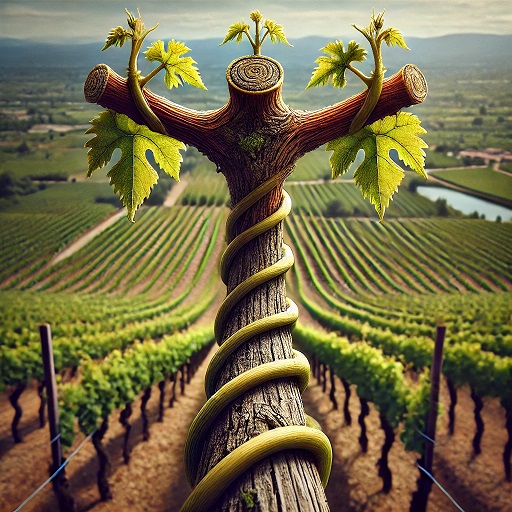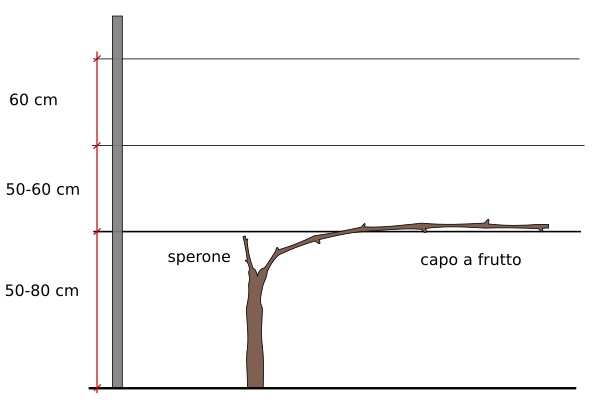Canopy Management
Grapevine Training


Grapevines must be trained annually.
Training is critical for shaping vines, controlling growth, and maximizing the efficiency of a vineyard.
Grapevine Training
Training refers to the way grapevines are pruned and guided to grow in a specific structure.
Training is used to control how the shoots, canes, and cordons (arms) are positioned.
Training is crucial for optimizing grape production, improving fruit quality, and making vineyard management more efficient.
Different training systems can be chosen based on factors like climate, grape variety, vine vigor, and desired fruit quality. The goal of training is to create a balance between the vegetative growth and fruiting parts of the vine, optimizing grape quality and yield:
Optimize Sunlight: Properly trained vines allow for better sunlight penetration to the leaves and grapes, which is critical for photosynthesis, sugar production, and ripening.
Improved Airflow: Training systems also allow better air circulation through the vine canopy, which reduces the risk of diseases such as powdery mildew or botrytis.
Control Growth: Training systems help manage vine growth by directing how shoots develop. This ensures vines don’t grow uncontrollably, which can affect fruit quality.
Yield and Quality: Training affects the vine's balance between vegetative growth and fruit production. Proper training can lead to healthier vines and higher-quality grapes.
Mechanical Efficiency: Many training systems are designed to accommodate mechanization, whether for pruning or harvesting, making vineyard management more efficient.
Training

|

|
| Head-trained vine all the spurs (permanent arms), are positioned around the head" of the trunk |
Cordon Trained |

Cane Training
Cane training involves selecting a few (usually one or two) long shoots (canes) from the previous season’s growth, which are tied to a trellis wire to guide the direction of growth for the new season.
Cane training helps control vine vigor by spreading out growth across the trellis, and ensures that the fruiting wood is renewed each year.
It also reduces the risk of disease by spacing out shoots and fruit.
Advantages
- Allows for even spacing of shoots and consistent fruit production each year
- Simple and effective for low to moderate-vigor vines
- Allows for good control over crop load and vine balance .
- Easy to manage in terms of pruning.
- The permanent structure allows for mechanical pruning and harvesting Long-term structure allows for consistent production over the years. Easier to maintain than cane-pruned systems. Suitable for mechanization, including pruning and harvesting.
Guyot
A Guyot system is commonly used for high-quality grape production in cooler climate regions like in Burgundy and Bordeaux, where grapevine vigor is lower, and fruit quality benefits from evenly spaced fruiting areas. It’s suitable for many grape varieties, including Pinot Noir and Chardonnay.
The images above illustrates a single Guyot system before and after winter pruning.
Single Guyot
In a Single Guyot system, one cane from the previous year’s growth is kept and tied horizontally along the trellis wire, while the other shoots are removed:

Double Guyot
In a Double Guyot (Bilateral Guyot) system, two canes (one on each side of the vine) are retained and tied down. This variant can be used in soils with good fertility, in which the plant can find sufficient nutrients and water resources to develop.

Multiple Guyot involves the presence of a vine that carries more than one branch along its height, each of which is equipped with a spur and a fruiting head. This system can only be used if the soil is sufficiently fertile.
Casalese Guyot is used in Piemonte, and in particular in the Monferrato area. It is similar to Guyot in its most classic meaning, with the only difference that the productive shoot is oriented perpendicular to the row.
Spur Training
Spur training involves cutting back the vine’s canes to short "spurs" (with 1-3 buds each) every winter. These spurs grow from a permanent cordon or the vine trunk itself. Shoots grow from these spurs each season.
Types:
- Cordon Training: The vine is trained to develop a permanent horizontal arm or "cordon" along the trellis wire. Spurs are distributed along this cordon.
- Head Training (Bush Vines): Vines are trained to grow like a bush, with no horizontal wires. Spurs emerge from a central trunk or head.
Purpose: Spurs provide more control over vine size and shape, making it easier to manage the growth each season.
Advantages: Easy to maintain and prune. Suitable for high-vigor vines, especially in hot climates.
Use Case: Common in warmer regions like California, Australia, and Spain (for head training), where high-vigor vines benefit from spur training to limit excessive growth.
Pergola (Overhead Training)

The Pergola (Tendone in Italy) system involves training the vines upwards onto a high horizontal trellis. The vines grow along the top, creating a canopy under which the grapes hang down. This is common in Italy and other Mediterranean regions.
Advantages: Provides shade to protect grapes from intense sunlight and heat. Increases air circulation under the canopy. Allows for large yields.
Use Case: Common in hot climates such as southern Italy, Spain, and Argentina, where grape varieties like Sangiovese and Malbec are grown. The shading effect helps prevent sunburn and maintains fruit quality.

Lyre System
The Lyre system is a horizontally divided canopy system where the vine grows in two separate arms, creating an open U-shape (or lyre). This helps manage high-vigor vines by reducing shading and increasing sunlight exposure.
Advantages: Maximizes sunlight exposure and air circulation. Reduces shading and improves fruit ripening. Increases yield potential.
Use Case: Suitable for vigorous grape varieties and regions where vine vigor needs to be controlled. The Lyre system is often used in warm regions with high sunlight and good soil fertility, such as parts of California and Australia.

Most vine training systems are designed to ensure adequate sunlight and air circulation throughout the canopy such as these Lyre trained vines in Napa Valley.

Watson Training

